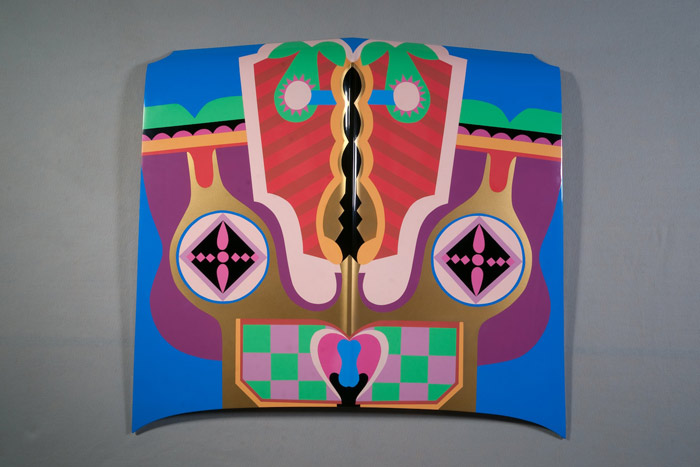Recently I had the pleasure of seeing “Chicago in L.A.: Judy Chicago’s Early Work, 1964-74,” at the Brooklyn Museum. Chicago, who is arguably one of the most influential feminist artists of this time, gained international notoriety for her installation The Dinner Party, which is permanently housed at the Brooklyn Museum. The pairing of these early works along side The Dinner Party is a testament to Chicago’s influence as an artist and underscores the social significance of this work. Chicago in L.A. features a variety of drawings, paintings, photographs and videos from this time period and reconsiders much of the work that would become the basis of The Dinner Party.
Chicago was born Judith Cohen in 1939 in Chicago, Illinois to parents Arthur and Mary Cohen. At an early age she showed an interest in art, which was encouraged by her parents who registered her for art classes at the School of the Art Institute of Chicago. She eventually enrolled at UCLA where the changing social landscape there would greatly influence the art she would come to create. In 1961 she married Jerry Gerowitz, whose surname she went by until 1970. Her husband unexpectedly died in a car crash in 1963, which prompted Chicago to continue to use his name. In a 1970 ad for Art Forum, Chicago under went another personal and professional transformation by unveiling her new self-given name taken from her home city, Chicago. The advertisement doubled as an announcement of her name change and also for an exhibition at California State College at Fullerton. This re-naming process marked a new period in Chicago’s life, which embraced the feminist movement and many of the community based tactics that came with it.
The trajectory of the show considers a ten year span in which Chicago underwent various personal and artistic changes. While in graduate school Chicago was famously criticized by a male professor for producing images that were too “womb and breast like,” which can be seen in pieces such as Mother Superette. She responded to this criticism by creating work for both her graduate thesis and work she would eventually produce for Rolf Nelson Gallery, which deviated from these forms. As the wall text notes, “she focused on painted sculptures in keeping with more geometric forms of East coast minimalism, incorporating the slick surfaces and lush colors that would come to define California’s Finish Fetish style.” Chicago would continue to use this approach to her art making process by repressing the more feminized imagery she had been inclined to make earlier in her career while adopting different approaches to her work. In many of the pieces from this era, a juxtaposition between non-traditional materials and practices can be seen. Chicago received training through an auto body school to study car painting techniques, which at the time was still considered to be a male-dominated space. She also learned to cast fiberglass and mastered the use of a variety of power tools in an effort to both inhabit these male spaces while also adding to her repertoire as an artist. These works were addressing her experiences as woman while simultaneously responding to the cultural and social realities of this time.
Chicago’s 2011 piece Birth Hood for example, which is a recreation of the 1964 original, illustrates the two worlds she was inhabiting at this time. The sculpture uses a car hood that was fabricated by Chicago. She then used auto body paint to create lush colors and biomorphic shapes that incorporated her own imagery and many of the car culture trends in L.A. at this time. This piece as well as many others featured in the exhibition showcases the development of the L.A. Finish Fetish moment. This art movement was occurring directly along side second wave feminism and consciousness-raising groups as well as the emergent car and counter culture.
Although Chicago’s work always contained female imagery within it, the shift from the late 1960s to the 1970s is striking. These later works would lay the foundation for The Dinner Party and can be seen in many of the paintings, drawings and performances from this era. By Chicago taking up China painting in 1972 for example, speaks to both her ingenious approach to non-traditional art practices while also embracing the more feminized elements to her work. Chicago’s 1973 Into the Darkness drawing features several petal-like layers varying in color from pink to green amidst a darkened center. Chicago would go onto create a series of related drawings, lithographs and paintings, which reflected this imagery and seemed to directly respond to the female form, while also gesturing towards the work of Georgia O’Keefe.
While I enjoyed the show overall, two things were missing for me. The first was an acknowledgment of the kind of privileged space Chicago inhabited at this time, despite the overt sexism she faced in male-dominated art and social spaces. The second missing factor was the lack of a dialogue her work had with many female artists of color who were emerging at this same time. Despite these shortcomings, “Chicago in L.A.” is an exciting representation of feminist art from this era, and is helping to expose the next generation of artists to Chicago’s work.
By Anni Irish
























